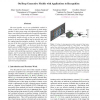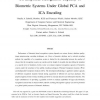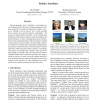1563 search results - page 246 / 313 » Face Hallucination and Recognition |
ICMCS
2005
IEEE
14 years 3 months ago
2005
IEEE
Behavioral indicators of deception and behavioral state are extremely difficult for humans to analyze. This research effort attempts to leverage automated systems to augment human...
CVPR
2011
IEEE
13 years 6 months ago
2011
IEEE
The most popular way to use probabilistic models in vision is first to extract some descriptors of small image patches or object parts using well-engineered features, and then to...
ACCV
2010
Springer
13 years 5 months ago
2010
Springer
We propose a method to measure similarity of shape for 3D objects using 3-dimensional shape subspaces produced by the factorization method. We establish an index of shape similarit...
TIFS
2008
13 years 10 months ago
2008
Performance of biometric-based recognition systems depends on various factors: database quality, image preprocessing, encoding techniques, etc. Given a biometric database and a se...
ICCV
2011
IEEE
12 years 10 months ago
2011
IEEE
Human-nameable visual “attributes” can benefit various recognition tasks. However, existing techniques restrict these properties to categorical labels (for example, a person ...



